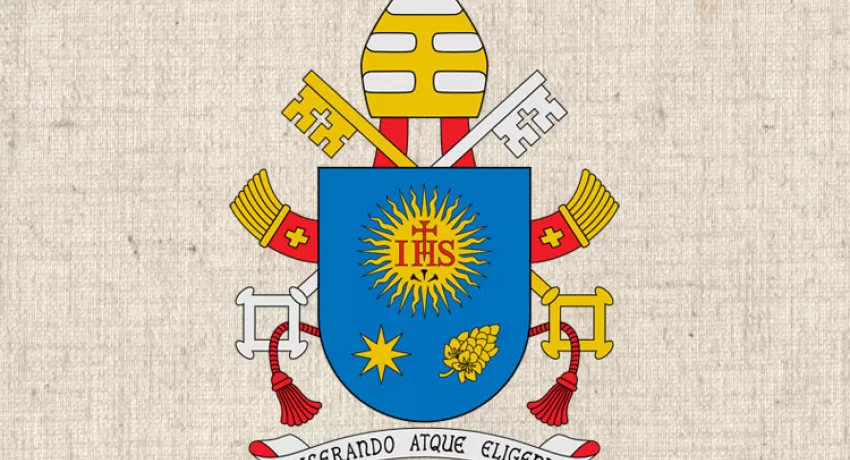From: Pope Francis
To: Monsignor Jesús García Burillo, Bishop of Avila
Dear Brother:
On March 28, 1515, a girl was born in Avila who in time would be known as Saint Teresa of Jesus. As the fifth centenary of her birth approaches, I turn my gaze to that city to thank God for the gift of this great woman and to encourage the faithful of the beloved Diocese of Avila and all Spaniards to know the history of this famous founder, as well as to read her books that, together with her daughters in the numerous Carmelite convents spread throughout the world, continue to tell us who and how Mother Teresa was and what she can teach us, the men and women of today.
In the school of this roving Saint we learn to be pilgrims. The image of The Way can synthesize very well the lesson of her life and of her work. She understood her life as a journey of perfection by which God leads man, dwelling after dwelling, to Him and, at the same time, starts on the path to men. On what paths does the Lord want to lead us, in the footprints and by the hand of Saint Teresa? I would like to mention four, which have done me much good: the path of joy, of prayer, of fraternity and of time itself.
Teresa of Jesus invites her nuns to “go, serving joyfully” (Way, 18, 5). True holiness is joy, because “a sad Saint is a sorry Saint.” Rather than being forced Saints, the Saints are the fruit of God’s grace to men. Each Saint manifests to us a feature of the multi-form face of God. In Saint Teresa we contemplate the God who, being “sovereign Majesty, eternal Wisdom” (Poem 2), reveals Himself to be close and a companion, who delights in conversing with men: God rejoices with us. And, born in the Saint on feeling His love was an infectious joy, which she could not dissimulate and which she transmitted to her surroundings.
This joy is a path that must be followed throughout life. It is not instantaneous, superficial, riotous. It must be procured already “at the beginning” (Life, 13, 1). It expresses the inner joy of the soul, it is humble and “modest” (cf. Foundations, 12, 1). It is not obtained by an easy path that avoids renunciation, suffering or the cross, but is found in enduring works and sorrows (cf. Life, 6, 2; 30, 8), looking at the Crucified and seeking the Risen One (cf. Way, 26, 4). So Saint Teresa’s joy was not egoistic or self-referential, but as that of Heaven. It consists in “rejoicing that all are joyful” (Way, 30, 5), putting oneself at the service of others with selfless love. As she said to one of her convents in difficulties, so the Saint also says to us today, especially to young people: “Do not cease to be joyful!” (Letter 284, 4). The Gospel is not a lead bag that is dragged with effort, but a source of joy that fills the heart with God and impels it to serve brothers!
The Saint also followed the path of prayer, which she described beautifully as a “friendship being often alone with the One we know loves us” (Life, 8, 5). When the times are “tough,” “strong friends of God” are necessary to support the weak (Life, 15, 5). To pray is not a way of fleeing, or putting oneself in a bubble, or isolating oneself, but of advancing in a friendship that grows all the more the more one addresses the Lord, “true friend” and faithful travel “companion,” with whom one can “suffer everything,” as He always “helps, gives strength and never fails” (Life, 22, 6). To pray “is not to think much but to love much” (Dwellings, IV, 1, 7); in turning one’s eyes to look at the one who does not cease to look at us lovingly and to suffer us patiently (cf. Way, 26, 3-4). God can lead souls to Himself on many paths, but prayer is the “sure path” (Life, 21, 5). To leave off prayer is to get lost (cf. Life, 19, 6). This advice of the Saint is of perennial timeliness. Go forward, then, on the path of prayer, with determination, without pausing, to the end! This is singularly true for all members of consecrated life. In a culture of the provisional, live the fidelity of “for ever, ever, ever” (Life, 1, 5); in a world without hope, show the fecundity of an “enamored heart” (Poem 5); and in a society with so many idols, be witnesses that “God alone suffices” (Poem 9).
We cannot go on this path alone, but together. For the reforming Saint, the path of prayer passes by the way of fraternity in the heart of Mother Church. This was her providential answer, born of divine inspiration and of her feminine intuition, to the problems of the Church and of the society of her time: to found small communities of women that, in imitation of the “Apostolic College,” would follow Christ, living the Gospel simply and supporting the whole Church with a life made up of prayer. “”He brought you here for this, Sisters” (Way, 2, 5) and this was the promise: “that Christ would go with us” (Life, 32, 11). What a lovely description of fraternity in the Church: to go together with Christ as brothers! To do this, Teresa does not recommend many things, but simply three: to love one another very much, to strip oneself of everything and to have true humility that “although I say it at the end is the principal base and embraces all the others” (Way, 4, 4). How she would desire, in these times, more fraternal communities where this path is followed: to walk in the truth of the humility that frees us from ourselves, to love others more and better, especially the poorest! There is nothing lovelier than to live and die as children of this Mother Church!
Precisely because she is a Mother with open doors, the Church is always walking toward men to take to them that “living water” (cf. John 4:10) that waters the garden of their thirsting heart. The holy writer and teacher of prayer was at the same time a founder and missionary on the roads of Spain. Her mystical experience did not separate her from the world or from people’s preoccupations. On the contrary, it gave her new impulse and courage for action and the duties of each day, because “the Lord is” also “among the cooking-pots” (Foundations, 5, 8). She lived the difficulties of her time, which were so complicated, without yielding to the temptation of bitter lament, but instead accepting them in faith as an opportunity to take another step on the path. Because, “it is always the time for God to do great favors to one who truly serves Him” (Foundations, 4, 6).
Teresa says to us today: Pray more to understand well what is happening around you and so to act better. Prayer conquers pessimism and generates good initiatives (cf. Dwellings VII, 4, 6). This is Teresian realism, which calls for works instead of emotions, and love instead of dreams, the realism of humble love in face of a laborious asceticism! Sometimes the Saint abbreviates her charming letters saying: “We are on the way” (Letter 469, 7.9), as an expression of the urgency to continue to the end with the task begun. When the world is burning, one cannot lose time in matters of little importance. May she infect all with this holy haste to go on the paths of our own time, with the Gospel in hand and the Spirit in our hearts!
“It is time to walk!” (Ana of Saint Bartholomew, Last Actions of Saint Teresa’s Life). These words of Saint Teresa of Avila, on the point of dying, are the synthesis of her life and become for us, especially for the Carmelite family, her Avila fellow countrymen and all Spaniards, a precious legacy to keep and enrich.
Dear Brother, with my cordial greeting, I say to all: It is time to walk, going on the paths of joy, of prayer, of fraternity, of time lived as a grace! Let us go on the paths of life by the hand of Saint Teresa. Her footprints lead us always to Jesus.
I ask you, please, to pray for me, as I need it. May Jesus bless you and the Holy Virgin take care of you.
Fraternally,
FRANCIS











